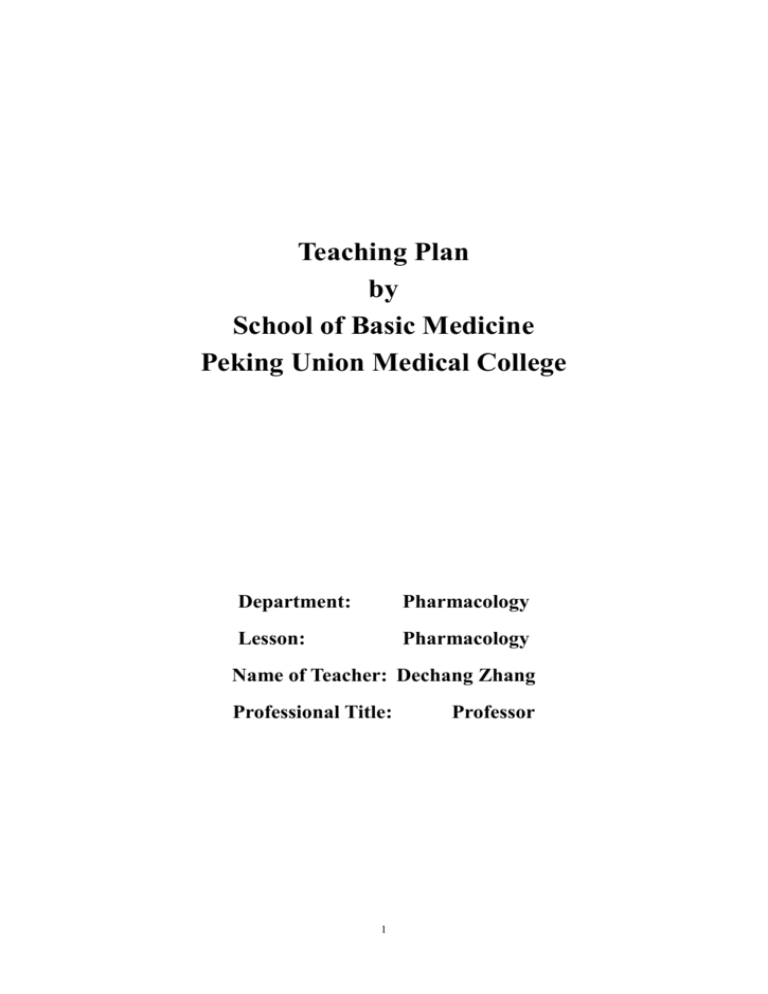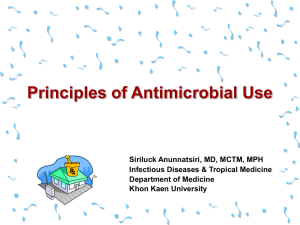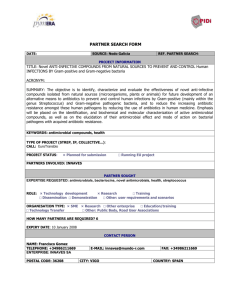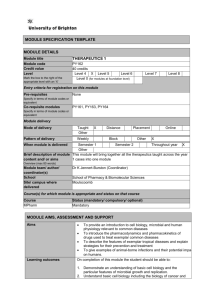中国协和医科大学
advertisement

Teaching Plan by School of Basic Medicine Peking Union Medical College Department: Pharmacology Lesson: Pharmacology Name of Teacher: Dechang Zhang Professional Title: 1 Professor Teaching topic: Teaching subjects: Hours: antibacterial drugs Teaching aims: 1. Medical Students 3 hours 2. 3. To master the principles of antibacterial drugs use; conceptions such as chemotherapy, antimicrobial drugs, chemotheraputic index (CI), antibiotics, antimicrobial spectrum, minimal inhibitory concentration (MIC), minimal bactericidal concentration (MBC), and drug resistance; the mechanisms of antimicrobial agents. To be familiar with. the mechanisms that bacteria produce drug resistance to agents To understand the methods of avoiding drug resistance Teaching content: Chapter 35 antibacterial drugs Emphases: 1. 2. the principles of antibacterial drugs use drug resistance Difficult Points: 1. 2. 3. the principles of antibacterial drugs use Measurement Principle of MIC, MBC drug resistance Evaluation methods Evaluation from students References 1..Rang and Dale’s Pharmacology 6th edition Rang HP, Dall MM, Ritter JM, Flower RJ , Churchill Livingstong, Elsevier, 2007 2.Golan DE, et al. Principle of Pharmacology, The pathophysiologic basis of drug therepy 2nd ed. 2008 3.Farrell SE, Priciples of Pharmacology, Workbook 2nd ed, 2008 Lippincott. 4.Finlel R.,et al. eds, Lippincott’s Illustrated Reviews: Pharmacology 4th ed. Lippincott 2009 5. 杨世杰主编《药理学》(8 年制规划教材),人民卫生出版社,2005 年 6. 张德昌主编《医学药理学》中国协和医科大学出版社 1998 年 2 Teaching aims Contents Chapter antibacterial drugs Methods TimeRemarks assignment 35 Comprehend Overview 5 min Comprehend ⅠHistory of antimicrobial therapy 5 min Master Media mix, ⅡPrinciples of explanation, question-raising antimicrobial use: 12 Factors to consider and discussion when selecting case study antimicrobial agents for therapy in patients 5 min Master 1. Is an antimicrobial agent necessary? 10 min Master 2. Identification of the pathogen 5 min Master 3. Empiric versus directed therapy 10 min Master 4. Need for bactericidal versus bacteriostatic agent 5. Determination of antimicrobial susceptibility of infective organisms 6. Pharmacokinetic and pharmacodynamic factors 10 min 7. Anatomical site of infection 8. Cost 9. Toxicity 10. Host factors 11. Antimicrobial combinations 10min 12. Antibiotic resistance concerns Classroom Q & A The summary and review 10 min Master Master Master Comprehend Master Master Master Master 15 min 15 min 5 min 10 min 10 min 10 min 10 min 5 min 3 Reflection questions References 1. 2. The current challenges of drug resistance and Solutions Can it do to compare the antibacterial activity of antimicrobial agents only through MIC? 1..Rang and Dale’s Pharmacology 6th edition Rang HP, Dall MM, Ritter JM, Flower RJ , Churchill Livingstong, Elsevier, 2007 2.Golan DE , et al. Principle of Pharmacology, The pathophysiologic basis of drug therepy 2nd ed. 2008 3.Farrell SE, Priciples of Pharmacology, Workbook 2nd ed, 2008 Lippincott. 4.Finlel R.,et al. eds, Lippincott’s Illustrated Reviews: Pharmacology 4th ed. Lippincott 2009 5. 杨世杰主编《药理学》(8 年制规划教材),人民卫生出版社, 2005 年 6. 张德昌主编《医学药理学》中国协和医科大学出版社 1998 年 4 Chapter 35 antibacterial drugs ⅠHistory of antimicrobial therapy ⅡPrinciples of antimicrobial use: 12 Factors to consider when selecting antimicrobial agents for therapy in patients 1. Is an antimicrobial agent necessary? 2. Identification of the pathogen 3. Empiric versus directed therapy 4. Susceptibility of infecting microorganism 5. Need for bactericidal versus bacteriostatic agent 6. Pharmacokinetic and pharmacodynamic factors 7. Anatomical site of infection 8. Cost 9. Toxicity 10. Host factors: Allergy history Age Renal function Hepatic function Pregnancy status Genetic or metabolic abnormalities Host defenses function 11. Need for combination therapy 12. Antibiotic resistance concerns 1. Is an antimicrobial agent necessary? • viral infections that do not respond to antibiotics • noninfectious processes mimicking a bacterial infection • culture isolation of an organism that is colonizing an anatomical site and not causing an infection In general, the clinician should resist temptation to begin antimicrobial therapy unless there is a reasonable probability that a bacterial infection is present. Another indication for antimicrobials is prophylactic therapy, which is intended to prevent illness in someone at risk of infection. 2. Identification of the pathogen Characterization of the organism is central to selection of the proper drug. 3. Empiric versus directed therapy The acutely ill patient with infections of unknown origin a neutropenic patient a patient with severe headache, a rigid neck, and sensitivity to bright lights(meeningitis) Therapy is initiated after specimens for laboratory analysis have been obtained but before the results of the culture are available. The choice of drug in the absence of susceptibility data 5 the site of infection the patient's history Broad-spectrum therapy may be needed initially for serious infections when the identity of the organism is unknown or the site makes a polymicrobial infection likely. 4.Need for bactericidal versus bacteriostatic agent Bacteristatic drugs arrest the growth and replication of bacteria at serum levels achievable in the patient, thus limiting the spread of infection while the body’s immune system attachs, immoblilizes, and eliminates the pathogens. Bactericidal drugs kill bacteria at drug serum levels achievable in the patient. They are more aggressive compare with bicteriostatic antimicrobial drugs . 5. Determination of antimicrobial susceptibility of infective organisms In the laboratory, susceptibility is most often measured using a disk diffusion test Stokes controlled sensitivity test An alternative measure of susceptibility is to determine the Minimum Inhibitory Concentration (MIC) and the Minimum Bactericidal Concentration (MBC) of a drug. A series of broths are mixed with serially diluted antibiotic solutions and a standard inoculum is applied. After incubation, the MIC is the first broth in which growth of the organism has been inhibited. The more resistant an organism is, then the higher will be the MIC. The MBC is measured by inoculating the broths used for MIC determinations onto drug-free medium. The MBC is the first dilution at which no growth is observed. 6. Pharmacokinetic and pharmacodynamic factors Oral: peak concentrations : 1 to 2 hours may be delayed by food or delayed intestinal transit vary widely in their oral bioavailability Most life-threatening infections are treated, at least initially, with IV agents. Parenteral therapy ensures adequate serum levels, and, for many agents, higher drug levels can be achieved when administered IV. Post-antibiotic effect (PAE) These agents also continue to inhibit growth of bacteria for several hours after the concentrations of the drug fall below the MIC in the serum. The Post-Antibiotic Effect (PAE) shows the capacity of an antimicrobial 6 drug to inhibit the growth of bacteria after removal of the drug from the culture. A longer PAE can therefore influence the clinical outcome of antimicrobial therapy. Most β-lactam agents do not exhibit concentration-dependent killing nor do they have a prolonged post-antibiotic effect. 7. Anatomical site of infection The site of infection often influences not only the agent used but also the dose, route, and duration of administration. The desired peak concentration of drug at the site of infection should be at least 4 times the MIC. Blood-Brain Barrier 8. Cost 9. Toxicity Because of nephrotoxicity and ototoxicity, aminoglycoside use has decreased with the development of β-lactams and fluoroquinolones with broad gram-negative activity. 10. Host factors Allergy history, Age, Renal function, Hepatic function, Pregnancy status, Genetic or metabolic abnormalities, Host defenses function 11. Antimicrobial combinations Synergism is present if the activity of the combined antimicrobial agents is greater than the sum of the independent activities. 12. Antibiotic resistance concerns Prevalence of antibiotic resistant bacteria Resistance in nosocomial infections Resistance in community acquired infections Antibiotic resistance can be intrinsic or acquired. Pseudomonas aeruginosa outer membrane Acquired resistance can be due to mutation of existing genetic information or acquisition of new genes. Mechanisms of bacterial resistance to antibiotics Combating Antibiotic Resistance Defining the Problem Solving the problem References 7








